Items
Site
The Medicine Chest
Is Part Of is exactly
SA College of Music
-
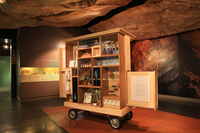
Chest: a botanical ecology
Illness and disease affect us all. The treatment of these conditions however, has been vast and varied, depending on the historical periods and the cultural context in and during which they are practiced. Situated in the rock art gallery, where healing power is expressed in San paintings, this mobile set of cabinets explores a rich complex of healing practices through the display of a medicine chest which was donated to the university of Cape Town in 1978. This chest belonged to a British dentist, who practiced in Cape Town from 1904, and who bought the chest for a hunting trip he undertook in 1913 to (then) Northern Rhodesia. The idea of the chest then gives rise to a variety of forms of healing: from instruments used to exorcise evil spirits and children's letters written to celebrate a heart transplant; to medicinal flowers bought at the Adderley Street flower market. The exhibition aims to visualise and materialise illness and its treatment from historical, cultural and disciplinary perspectives. Drawing on well-established historical and contemporary connections between the disciplines of Botany, Medicine and Pharmacology, the exhibits also suggest latent links which are at times political, at times whimsical. -

Healing instruments
“I invited Edmund February to the Kirby collection to view the instruments and learn his thoughts on them from a botanical perspective. February identified the dancing rattles as being made of the seed pods of Oncoba spinosa (Venda: mutuzwa) and the seed pod of Adansonia digitata (Venda: muvhuyu). The wood of the iodophone was, however, unrecognisable as a result of its handling. February also contacted colleagues in the Department of Zoology and the School of Mathematical & Natural Sciences at the University of Venda, who connected me to a Venda diviner, Muanalo Dyer, who uses similar baobab rattles (and other materials from that tree) in her healing practices. This interdisciplinary engagement showed that these instruments, supposedly frozen in their early 20th century understanding of being on the brink of extinction, remained very much functional in the present” (Liebenberg 2021: 271). -
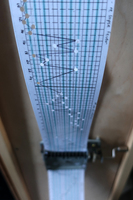
Listen Laennec
"In this work, the temperature graphs of individuals suffering from malaria, yellow fever, trypanosomiasis and tickborne-relapse fever – all viewed as ‘tropical’ and treatable by the contents of the medicine chest – were converted into a musical score. I punched the strips of paper of a hand-cranked musical box mechanism with holes that corresponded to the graphs – the vertical axis representing temperature variations and the horizontal axis representing the approximate number of days the fever is said to last. The translation of these graphs into notes seems nonsensical, as we do not listen for a temperature; we measure it by feeling a forehead or taking a reading with a thermometer. The practice of listening has, however, been part of the history of medicine since the days of Hippocrates (c.460–c.370 BC), when physicians performed auscultations of the lung and heart by placing their ear directly on the patient’s chest' (Liebenberg 2021: 265). -

Isigubu through Gqom
"In 2018, the Zulu drum alleged to have been played during the 1906 Bambatha rebellion against British rule and unfair taxation in the colony of Natal (discussed by Nixon) became the focus of Amogelang Maledu’s Honours research project. In ‘Isigubu through gqom: The sound of defiance and Black joy’, Maledu (who has an undergraduate degree in Anthropology and Visual Culture) used the drum’s history of colonial resistance and contextualised it through the contemporary musical genre of gqom, showing music as both an act and celebration of joy and freedom and of defiance against the limitations of township life. Through her ‘speculative and imagined interconnectedness’ of the isigubu and gqom, Maledu appropriated the limited information available about the former and expanded it by reinventing new historical pathways that reframed colonial narrations and aesthetics (Maledu 2018: 29–30). Her curation broke the silence of the Kirby instruments and liberated the isigubu from its ethnomusicological framework through a juxtaposition that spoke back to history and the contemporary moment. In addition, a website provides a framework for historicising gqom and encouraged the growth of its archive through viewer engagement, also highlighting the speculative and stagnant colonial archive in which the isigubu is situated (Maledu 2018: 29–30)" (Liebenberg 2021: 211 - 212). -
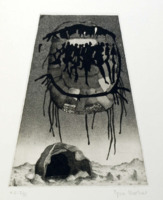
Etching from 'Sound from the Thinking Strings'
"Skotnes’s own visual interpretation of the history and cosmology of the |xam formed the last component of this interdisciplinary endeavour and constituted a visual component that drew together the various strands of disciplinary interpretations and presented a perspective on the |xam life she felt ‘was missing from the other interpretations’ (Skotnes 1991: 30). In these images she drew freely on San mythology, accounts of |xam life recorded by Lucy Lloyd, historical and archaeological research and images from rock paintings in a landscape setting. She writes in her preface that these etchings were direct attempts at ‘inverting the museum dioramas’ in the ethnographic halls close to the exhibition and which, through their display of the San’s body casts, rendered them closer to specimens of biology than as members of a highly developed culture (Skotnes 1991: 52). By creating images that combined shamanistic rituals, entoptic spirals, plants, hunting bags, bows and arrows, snakes, eland-shaped rainclouds, colonists, musical instruments, shelters and therianthropic shapes, Skotnes eclipsed the static narratives of the dioramas and the object labels in the exhibition, placing them in a context in which their metaphysical qualities were celebrated more than their physical qualities. These prints stood in striking contrast to the other exhibits, which framed the San as physical types, and they challenged viewers to confront the reality that the San had a rich history and cultural and social life" (Liebenberg 2021: 157). -
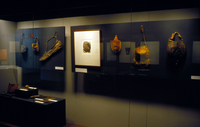
Sound from the Thinking Strings (installation detail)
"Skotnes had a longstanding relationship with the museum, which started when she was still a student at the Michaelis School of Fine Art. Davison remembers that Skotnes would visit the taxidermy section of the South African museum to draw bones. As an anthropologist, Davison admits to finding Skotnes’s way of looking at things stimulating – an individual way of looking at objects that made her look at them differently, even though she was already very familiar with these materials. Davison recalls a visit to the ethnographic stores during which she showed Skotnes the San skin bags, carefully conserved in their drawers and laid out on acid-free paper. Skotnes admired not only their aesthetic qualities but related the stories she had been studying in the Bleek and Lloyd archive to them – stories that shifted their status from anthropological museum objects to powerful animate objects in San spiritual and social life (P. Davison, personal communication, 28 January 2021). Skotnes remembers that she asked staff whether they knew what was inside the bags and was shocked when nobody could remember looking in them. She was allowed to look inside one and found a claw, which they thought must be a leopard’s (P. Skotnes, personal communication, 9 May 2021)" (Liebenberg 2021: 2015). -
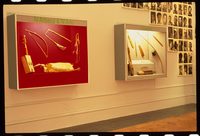
Miscast (installation detail)
Instruments from the Kirby collection displayed as part of the 'Miscast' exhibition. -
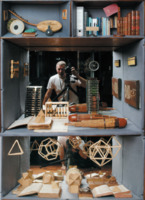
Page 135 of the Curiosity CLXXV catalogue
"Peering into one of them could, for instance, reveal musical instruments from the South African College of Music’s Kirby collection; old wooden mathematical models of abaci and polyhedrons from the Maths department; mobiles demonstrating platonic solids made by mechanical engineering students; publications by a UCT Professor of Astronomy; a sign pointing to ward D10 from the old section of Groote Schuur Hospital; glass slides once used as a teaching aid for art history at Michaelis; bird ringing material from the Avian Demography unit; and a bottle-brush plant labelled by the son of one of the curators" (Liebenberg 2021: 179). -
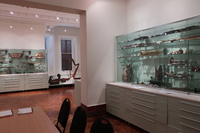
The Kirby collection of musical instruments
"Kirby’s choice of an ‘age-old simple classification’ to order the instruments can be correlated with another classification formulated at Wits around the time he was collecting. The Department of Bantu Studies was established in the 1920s at roughly the same time as the Music Department. Kirby’s use of the phrase ‘native races’, which features in the title of his book, resonates with the descriptive subtitle of the Wits journal connected to research in this department: Bantu Studies: A Journal Devoted to the Scientific Study of Bantu, Hottentot, and Bushman (Nixon 2013: xii). The homogenising act of categorising all diverse indigenous South African groups into three general categories seems to echo Kirby’s taxonomic imposition on the diverse instruments he collected on his trips and that continues to feature as the ordering principle of this collection" (Liebenberg 2021: 136). -

Similitude
"In 'Similitude', Langerman brought together a selection of objects from three disparate disciplines – glassware from chemical engineering; a skull with an arrow embedded in it and a torch used as a murder weapon from forensic pathology; and two flutes from the Kirby collection. Ignoring the assigned functions the objects performed within their respective disciplines, she chose instead to use their formal characteristics as a taxonomic device. They were all, as she described them, ‘long thin things’ (Langerman n.d.). In displacing these objects from their respective disciplines and positioning them in proximity to objects that shared this new category, she neutralised their disciplinary functions and flattened their meanings within those fields (Langerman n.d.)" (Liebenberg 2021: 183). -

Rattles in the Kirby collection
A drawer of rattles in the South African College of Music's Kirby collection: "The instruments are now grouped in different cabinets according to the taxonomy set out by Kirby in his book. In the preface to the second edition (1964), Kirby shares some of his considerations when deciding how to group the instruments, writing that he had to decide ‘whether to arrange his material tribally, or to deal with each type of musical instrument separately from the technological and historical points of view, allowing the tribal aspects to emerge incidentally’ (Kirby 1964: xi). Kirby chose the second alternative, stating that his chief reason was that he wanted the work to be, as far as possible, ‘a complete and comparative study of one particular aspect of the life of our aborigines’ (1964: xi). His second consideration was to find the most suitable manner for classifying the instruments, for which he defaulted to the ‘age-old simple classification of musical instruments into three main groups of percussion, wind and strings’ (1964: xi) – a Western system for the classification of instruments and the principles on which they were based. The chapters in his book and the displays in the room are thus grouped into three categories: percussion – ‘rattles and clappers’, ‘drums’, ‘xylophones and sansas’ and ‘bull-roarers and spinning-disks’; wind instruments – ‘horns and trumpets’, ‘whistles, flutes, and vibrating reeds’ and ‘reed flute ensembles’; and stringed instruments – ‘stringed instruments’ and ‘Bushmen and Hottentot violins and the ramkie’. Kirby encountered one taxonomic anomaly when employing this system: the ‘gora’, an instrument both wind and string, which he termed ‘a stringed-wind instrument’" (Liebenberg 2021: 135). -

Breath on a piano
Chromogenic color print -

Ma
The Japanese have a word, ‘ma’, for this interval which gives shape to the whole – this ‘gap’, ‘opening’, ‘space between’ or ‘time between’. Ma is not something that is created by compositional elements, rather it can be understood as the thing that takes place in the imagination of the human who experiences these elements. A room, for example, is called 'ma', as it refers to the space between the walls. Or a rest in music, which indicates a pause between the notes or sounds (Pilgrim 1986: 255). -

Perpetuum Mobile (2400KG)
Water, bucket, hydrophone, mist-machine, 2 400kg cement, relay timer, amplifier and cable. Water is set in motion by means of ultrasound (at times amplified by loudspeakers), generating steam that slowly spreads through the exhibition space and envelops sacks of cement whose mass is changed as the exhibition proceeds by the meandering atmospheric humidity. -

Observing marbling in Edirne
A marbling demonstration observed during a 2012 trip to Istanbul and a visit to the neighbouring Edirne's Health Museum. Opened in Sultan Bayezid II külliye in 1488, the hospital treated patients for over 400 years, until 1909, along the tradition of Turkish-Islamic medicine, which included the treatment of diseases by music. -

Years
“On regular vinyl, there is this groove that represents however long the track is. There’s a physical representation of the length of the audio track that’s imprinted on the record. The year rings are very similar because it takes a very long time to actually grow this structure because it depends on which record you put on of those I made. It’s usually 30 to 60 or 70 years in that amount of space. It was really interesting for me to have this visual representation of time and then translate it back into a song which it wouldn’t originally be " (Traubeck 2012). This record features seven recordings from different Austrian trees. They were generated on the Years installation in Vienna, January 2012. -
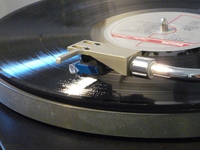
Mozart's Antimony
Medical bedside cabinet, gramophone player with a hypodermic needle substitution, Mozart’s Sonata in C, KV 279 and Sonata in D, KV 576. The needle is slowly scratching irreparable grooves into the record whilst the record in return, is making the needle blunt.. "On 20 October 1791, Mozart told his wife Constanza that he was being poisoned. On 20 November he developed a fever; his hands, feet and stomach became swollen, and he had attacks of vomiting. He died on the 5th of December. Although Antonio Salieri confessed to Mozart’s murder several years later, it is highly unlikely as Salieri suffered from senile dementia. In 1991, Ian James of London’s Royal Free Hospital attributed Mozart’s death to antimony, a poison that Mozart may have been given by his doctor - not to kill him but to cure him. Antimony was prescribed for what was then diagnosed as melancholia. In small doses it leads to headaches, fainting and depression. In large doses it can be fatal within days (Emsley 1999: 225). In the autumn of 1791, Mozart, suffering from severe depression, exacerbated by debt, the ill reception of his new work La Clemenza di Tito, and a commission to write a requiem which he believed was for his own funeral, dosed himself with a variety of medicines – one of these being antimony – and what was meant to cure, killed" (Liebenberg 2011: 85 - 91). -
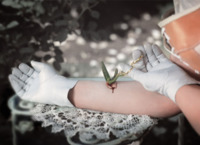
Resonance
"The revelation of my object-study that the chest was a lacuna in terms of local botanical medicinal remedies and practices served as inspiration for the first department I approached. By engaging with insiders of the Department of Biological Sciences, I reasoned that I could supplement the chest’s Western content with local botanical knowledge. As the first viewing session, it was also the one that initiated the weakening of the chest’s imperial viral load through an inoculation of additional meaning – a treatment with a surprising side-effect. On presenting the chest to other disciplinary insiders afterwards (to Pathology and the College of Music, for example), I noticed characteristics that also resonated with the field of botany within these disciplines and their collections. These botanical resonances accrued as my disciplinary engagements increased and diversified, leading me to embrace this side-effect and to use botany as the central theme of my exhibition. The resonances generated in the different departmental viewing sessions resulted in new links with the chest but also in connections surfacing between disciplines such as zoology, dermatology, pharmacology and sound studies, for example. I drew on these visits and their outcomes to create a range of artworks that materialised the inoculation of the chest by manifesting how intersecting with diverse fields expanded its meaning, and I sourced objects from the collections that encouraged new interpretations" (Liebenberg 2021: 244 - 246). -

Prrrip-Prrrip, Tseeeep!: the silence of birds’ eggs
"Birds are highly vocal creatures, their songs sound everyday in almost every habitat, even our concrete cities. These calls have been likened to the human capacity for speech, yet the faculty of language has, for most of history, been described as solely ‘human.’ Language forms one of several traits deployed to uphold the constructed divide between human and non-human animals. Oology – the collecting and documenting of wild bird eggs – was an obscure hobby and ‘science’ of the past. Collected eggs were pierced and ‘blown’ of their contents. The perfect shells, beautifully coloured with speckles and intricate patterns, were then placed in vast cabinet collections. Such a birds’ egg collection, collected in Southern Africa during the last half of the 20th century, forms the starting point of this exhibition. Through exploring language and communication in birds, this exhibition aims to create an affective environment for re-evaluating the collecting practices of the past (with its ties to the Euro-Western, human-centered perspective), and for re-imagining current natural history collections. It also aims to … poo-too-eee poo-too-eee, pa-chip-chip-chip per chick-a-ree. Ka-ha, ka-ha, kuh-uk-uk-uk! caw-caw-caw-caw-koodle-yah, loooooo-eee! Pa-chip-chip-chip, per-chick-a-ree!" Wall text of exhibition, Prrrip-Prrrip, Tseeeep!: the silence of birds’ eggs -
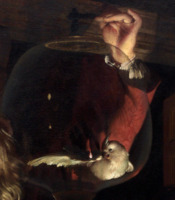
Canary
Sentinel species are used to detect risks to humans by providing advance warning of a danger. The idea of placing warm-blooded animals in a mine to detect carbon monoxide was first proposed by the Scottish physiologist John Scott Haldane in 1913. Canaries (Serinus canaria ) were considered the best sentinel animals for detection of dangerous gases because they were found to be more sensitive than other species evaluated (Pollock 2016:386-387). -
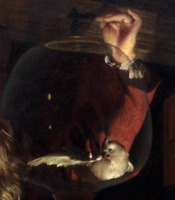
Flight
A chorus of juvenile heartbeats affected by Atrial Septal (ASD) and Ventricular Septal Defects (VSD), Patent Ductus Arteriosus(PDA), and Aortic Valve Stenosis (AVS), transposed to a higher frequency to simulate birdsong -
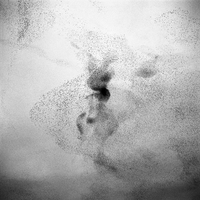
Murmeration
Heart murmurs are sounds – such as whooshing or swishing – made by turbulent blood in or near the heart. When doctors listen to a child's heart, what they usually hear is a simple rhythm: "lub-dub, lub-dub, lub-dub..." Sometimes, they'll hear an extra sound in between the lub and the dub. That extra sound is called a heart murmur. Heart murmurs can be harmless or abnormal. In the case of the latter, it is usually the result of abnormal blood flow through the heart caused by a heart valve not working properly. -

Igemfe
"The transverse flute is rarely seen among the Zulu, who, if they make and use it, call it igemfe, the name of a totally different instrument. I possess three specimens, one from Inchanga, one from Pietermaritzburg district, and one from Ixopo. The first two are open at the end opposite the embouchure, and have three finger-holes; the third is a curiously aberrant example, being closed at both ends and having four finger–holes arranged in pairs" (Kirby 2013: 179) Hornbostel-Sachs number: 421.121.32 Stopped side-blown flutes with fingerholes, Length: 291mm (11.4in), Diameter: 36mm (1.2in), Place of production: St. Michael's-on-Sea (KwaZulu-Natal, South Africa). -

Resonance
Demonstration of sympathetic vibration using the optical (flame) microphone


